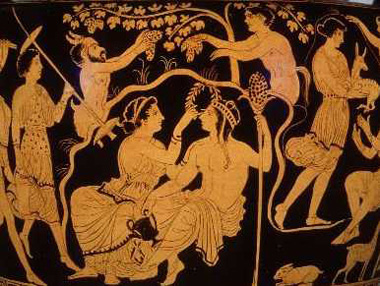
Origins of Inebriation Revealed
揭示醉酒的起源
This cuneiform text dates back to the 6th year ofprince Lugalanda who ruled about 2370 B.C. in southern Mesopotamia.It is an administrative document concerning deliveries of three sorts of beer to different recipients
这种楔形文字的历史可以追溯到公元前2370年左右,王子卢加尔安达在美索不达米亚南部统治的第六年。它是一种行政文书,将三种啤酒传递到不同的人手中。
In prehistoric Eurasia,drugs and alcohol were originally reserved for ritual ceremonies, and weren'tused merely to satisfy hedonistic motives, a new study suggests. What's more,given the sacred role of the substances, their use was likely highly regulatedand only available to elite citizens.
一项新的研究表明,在史前的欧亚大陆时期,毒品和酒精的最初用于宗教仪式,而不是仅用来满足人们享乐。更重要的是,考虑到这些物质神圣的角色,它们的使用几乎是受到高度控制的,仅供给于杰出公民。
Many Eurasian cultures are known to have anancient history with psychoactive substances, as evidenced by early writtendocuments. The Greek historian Herodotus, for example, once described theScythians' (Iranian equestrian tribes) post-funeral purification ceremonyinvolving hemp, which dates back to the fifth century B.C.
据早期的书面文件证明,许多欧亚文化是已公认拥有一种精神活性物质的古代历史。例如,希腊历史学家希罗多德曾经描述斯基泰(伊朗马术部落)葬礼的净化仪式中涉及大麻,而这可追溯到公元前第五世纪。
But written records aren't the onlyindication of early drug and alcohol use.
但是文字记录并不是早期使用药物和酒精的唯一痕迹。
"It is generally thought thatmind-altering substances, or at least drugs, are a modern-day issue, but if welook at the archaeological record of prehistoric Europe, there are many datasupporting their consumption," said study author Elisa Guerra-Doce, aprehistory expert at the University of Valladolid in Spain. "Apart fromthe presence of macrofossil remains of plants with these [mind-altering]properties, there are artistic depictions of opium poppies, for instance, andsome designs in megalithic tombs may have been inspired by altered states ofconsciousness."
“人们普遍认为,改变意识的物质,或者说是药物,是一个现代议题,但如果我们看看欧洲史前考古记录,这儿有很多数据可以证明他们的假设,”该研究的作者西班牙巴利亚多利德大学史前史专家艾丽莎·格拉-多西说道,“除了存在改变意识的植物化石,还有对罂粟的艺术描绘,例如,巨石墓里的一些设计可能会激发人们改变意识形态。”
Despite numerous indications,archaeologists have largely overlooked the use of mind-altering substances inEurasian prehistory. So Guerra-Doce decided to sort through the scarce andscattered information in the scientific literature, in hopes of gaining abetter understanding of the history and context of ancient drug and alcoholuse.
尽管有许多迹象表明,考古学家已经在很大程度上忽略了欧亚史前使用改变思想的物质。所以格拉-多西决定整理科学文献中稀少且分散的信息,以更好地理解历史和古老药物酒精使用的文本信息。
She reviewed four lines of evidence:macrofossil remains of psychoactive plants, residues from fermented alcoholicdrinks, psychoactive alkaloids (chemical compounds) on artifacts and skeletalremains, and artistic depictions of psychoactive plants and drinking scenes.
她回顾了四条证据:含有精神活性植物的大化石,发酵的酒精饮料残留物,文物和遗骨的活性生物碱(化合物)以及精神活性植物和饮用场景的艺术描写。
Widespread use
广泛使用
In prehistoric sites throughout Europe, archaeologists have found the remains of numerouspsychoactive plant and fungi species, including opium poppy, deadly nightshade,hallucinogenic mushrooms and ergot fungus. However, it's not always possible todetermine how people used the substances, if they did at all.
在整个欧洲的史前遗址上,考古学家已经发现许多精神活性植物和真菌物种的遗址,包括鸦片罂粟,颠茄,致幻蘑菇和麦角菌。然而,如果人们都使用这种物质,决定人们使用这些物质的可能性并不大。
For instance, at a Neanderthal burial caveat Shanidar, in northern Iraqdating to around 60,000 B.C., researchers discovered the remains of manymedical plant species, suggesting the grave belonged to a shaman. But otherscientists argue that a gerbil-like rodent called the Persian jird may havebrought the plants into the cave after the Neanderthal there had died.
例如,追溯到公元前60000年前,在伊拉克北部的一个尼安德特人沙尼达尔墓穴中,研究人员发现,许多药用植物的遗骸,而这坟墓属于一个萨满的。但是其他科学家认为,一种长爪沙鼠类的啮齿类动物,名叫波斯沙鼠可能在尼安德特人死了后,将植物带进洞穴。
Yet many archaeobotanical finds providestrong evidence for the prehistoric use of mind-altering substances. Inparticular, at an archaeological site near Bucharest, Romania,scientists found charred Cannabis seeds from plants in some tombs. The mainpsychoactive compound of marijuana is tetrahydrocannabinol(THC), which is mostabundant in the female plants (Cannabis plants are typically either male orfemale, with male plants producing pollen that pollinates the seed-producingflowers of the female plant)."The presence of burnt seeds in these tombsproves that the prehistoric societies of eastern Europe were aware of this, andconsequently, they burnt female plants," Guerra-Doce told Live Science.
然而许多大型植物剂被发现并提供了强有力的证据,证明在史前时期人们使用过改变意识的物质。特别是,在罗马尼亚布加勒斯特附近的一个考古遗址上,科学家们在一些坟墓里发现了烧焦的大麻种子植物。大麻的主要活性化合物是四氢大麻酚(THC),这是最丰富的雌性植物(大麻植物通常是雄性或雌性,与雄性植物产生花粉,授粉的种子生产雌性花植物),“在这些墓葬中存在的烧焦种子证明了东欧的史前社会已经意识到这一点,因此,他们燃烧雌性植物,”格拉-多西对生活科学说道。
Alcoholic residues suggest many prehistoricEurasians drank fruit wines, mead, beer (from barley and wheat) and fermenteddrinks made from dairy products.
酒精残留物暗示了许多史前欧亚的水果酒,蜂蜜酒,啤酒(大麦和小麦)和发酵饮料都产自于乳制品。
The discovery of alcoholic fermentationappears to date back to about 7000 B.C. in China. By 5000 B.C., people in theZagros Mountains of northwestern Iran drank wine instilled with pineresin (for its preservative or medicinal properties). And at a site insoutheastern Armeniadating to 4000 B.C., scientists unearthed a fully equipped winery — they thinkthe wine was made for mortuary practices, considering there were 20 burialgraves, which contained drinking cups, next to the winemaking facility.
在中国酒精发酵的发现原理可追溯到大约公元前7000年前。公元前5000年,在伊朗西北部的扎格罗斯山脉的人们在喝酒时逐渐滴入松树树脂(以达到防腐剂或药用性能的效果)。追溯到公元前4000年,在亚美尼亚东南部的一地区,科学家发现一个设备齐全的酒厂——他们认为酒是用来墓葬的,因为酿酒厂有20座葬墓群,坟墓里都有酒杯。
Importantly, though some pottery fragmentscontaining residues of beer and wine come from settlements, most actually comefrom burial sites. "Many tombs have provided traces of alcoholic drinksand drugs," Guerra-Doce said. "I think these substances were used toaid in communication with the spirit world."
重要的是,尽管一些瓷器碎片含有殖民地啤酒和葡萄酒的残留物,然而,大多数的残留物来自墓地。“许多坟墓留有酒精饮料和药物的遗迹,”格拉-多西说,”我认为这些物质是用来帮助精神世界交流的。”
Some artistic representations also hint atceremonial drug and alcohol use in prehistory. One of the most revealing itemsmay be a 30-inch-tall (76 centimeters) terracotta figurineknown as the"Poppy Goddess." The figurine, found in an almost 3000-year-old cultchamber in Crete, depicts a bare-breastedwoman with upraised arms and a head bearing three movable hairpins shaped likepoppy capsules. Certain features of the capsules suggest how opium may havebeen extracted, and the figurine displays a serene facial expression, whichsome experts interpret as depicting a trancelike state gained from inhalingopium fumes.
一些艺术再现也暗示了史前时期药物和酒精用于礼仪场合。一个最明显的项目可能是一个30英寸(76厘米)高的陶瓦小雕像,被誉为“罂粟女神。”这个小塑像发现于克里特岛(希腊)的祭祀场所,已有大约3000年得历史,描绘了一个坦胸露乳的女人,她高举双手,头上插了三根像罂粟壳似的可移动簪子。胶囊的某些功能暗示了鸦片可能已经被提取,而雕像显示了一个安详的表情,一些专家解释为这是鸦片烟吸入后的恍惚状态。
Only for the elite?
只面向精英?
Guerra-Doce's analysis further suggeststhat psychoactive substances may have been reserved for the elite. "Themain evidence to support that idea is the archaeological contexts where theyhave been found: tombs of high-status individuals and restricted ceremonialplaces," she said.
格拉-多西的分析进一步表明,精神活性物质可能是给精英保留的。” 支持这个想法的主要证据来是考古信息,他们已经发现:高官的坟墓和限制仪式的地方,”她说。
For example, at a Bronze Age cemetery insoutheastern Spain,archaeologists have found psychoactive alkaloids of opiates in tombs of theupper class. Similarly, a luxurious tomb in another area of Spain containedevidence of the hallucinogenic alkaloid hyoscyamine, which comes from thenightshade family of plants.
例如,在西班牙东南部的一个青铜时代墓地,考古学家在上层阶级的坟墓里发现的阿片类药物活性生物碱。同样,在另一个地区的西班牙豪华墓地中发现了致幻生物碱莨菪碱的证据,而这些碱属于茄科植物。
Alcohol also seems to have been mainly forthe upper class. One of the most impressive examples comes from the so-calledHochdorf Chieftain's Grave in Germany— a Celtic burial chamber for a 40-year-old man that dates to around 530 B.C.In the princely tomb, researchers found an enormous bronze cauldron from Greece thatcontained 350 liters (92 gallons) of mead.
酒精也似乎是主要为上层阶级服务的。其中最引人注目的例子是来自所谓的侯赫多尔夫的酋长的坟墓---追溯到公元前530年左右,一个40岁凯尔特男子的墓室。在王侯墓前,研究人员发现了一个巨大的希腊青铜鼎,其含有350公升(92加仑)的酒。
"I think that prior to a large-scaleproduction, [alcoholic drinks] were reserved for special events, and theyplayed a similar role as drug plants," Guerra-Doce said.After large-scaleproduction became possible, alcohol likely became available to many people (notjust elites), and its use shifted from ritualistic to hedonistic in nature, sheadded.
“我认为,大规模生产之前,[酒被保留用于特殊事件,植物药也发挥了类似的作用,”格拉-多西说。在大规模生产成为可能时,酒精可能提供给许多人(不只是精英),其用途在性质上说是从仪式到享乐主义,她补充说道。
Drug plants, on the other hand, were nevercultivated on a large scale. And though they were also eventually consumed forhedonistic purposes, this use is difficult to observe in the archaeological record,Guerra-Doce said. "Interestingly, the common names of some of these plantsrefer to madness, to evil spirits, to harmful effects, so I think a taboo wasimposed in order to avoid their use for hedonistic purposes," shesaid.
另一方面,植物药并没有一个大规模栽培。虽然他们也最终是达到享乐主义的目的,但是这是很难在考古记录中发现的,格拉-多西说。“有趣的是,这些植物中的一些的共同名字指的是疯狂行为,魔鬼精神,有害影响,所以我认为一个禁忌是用来避免达到享乐目的的,”她说。












